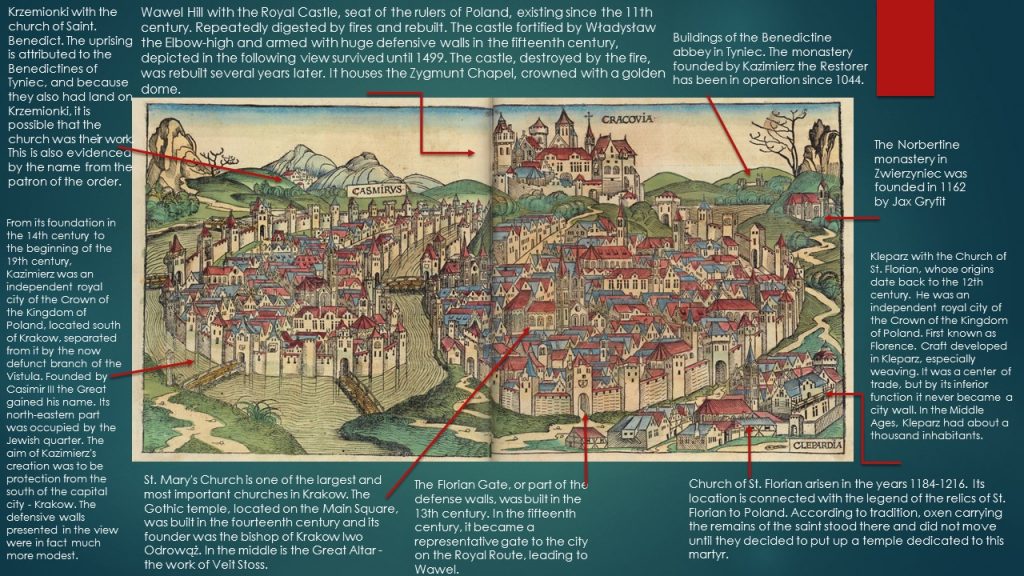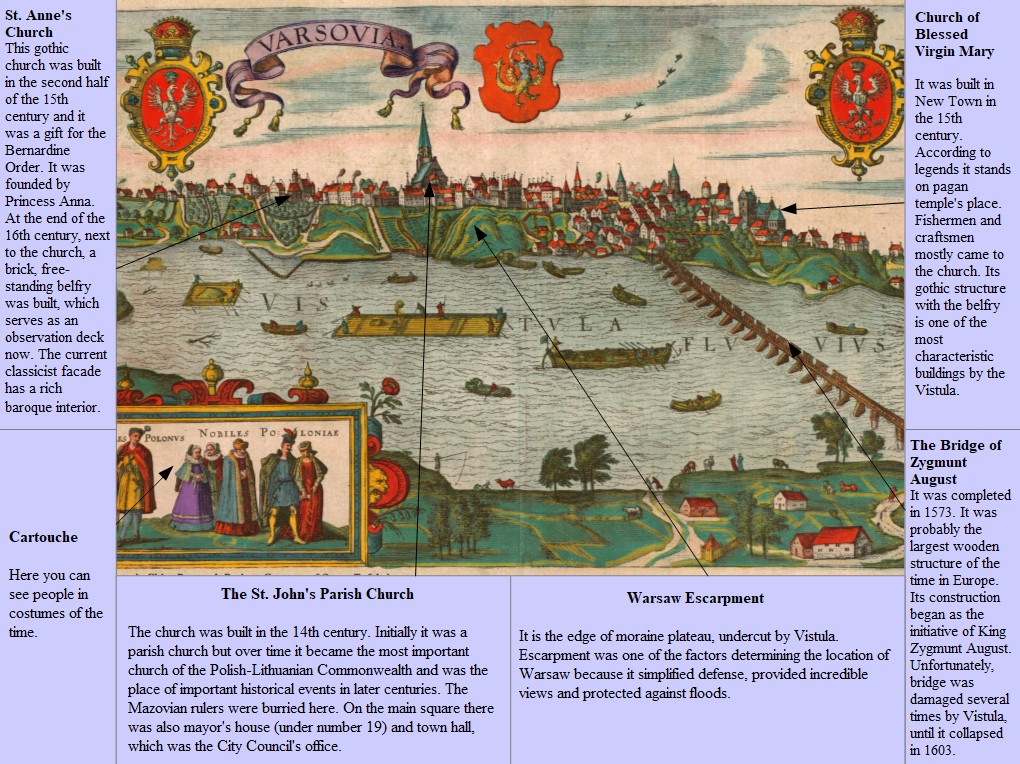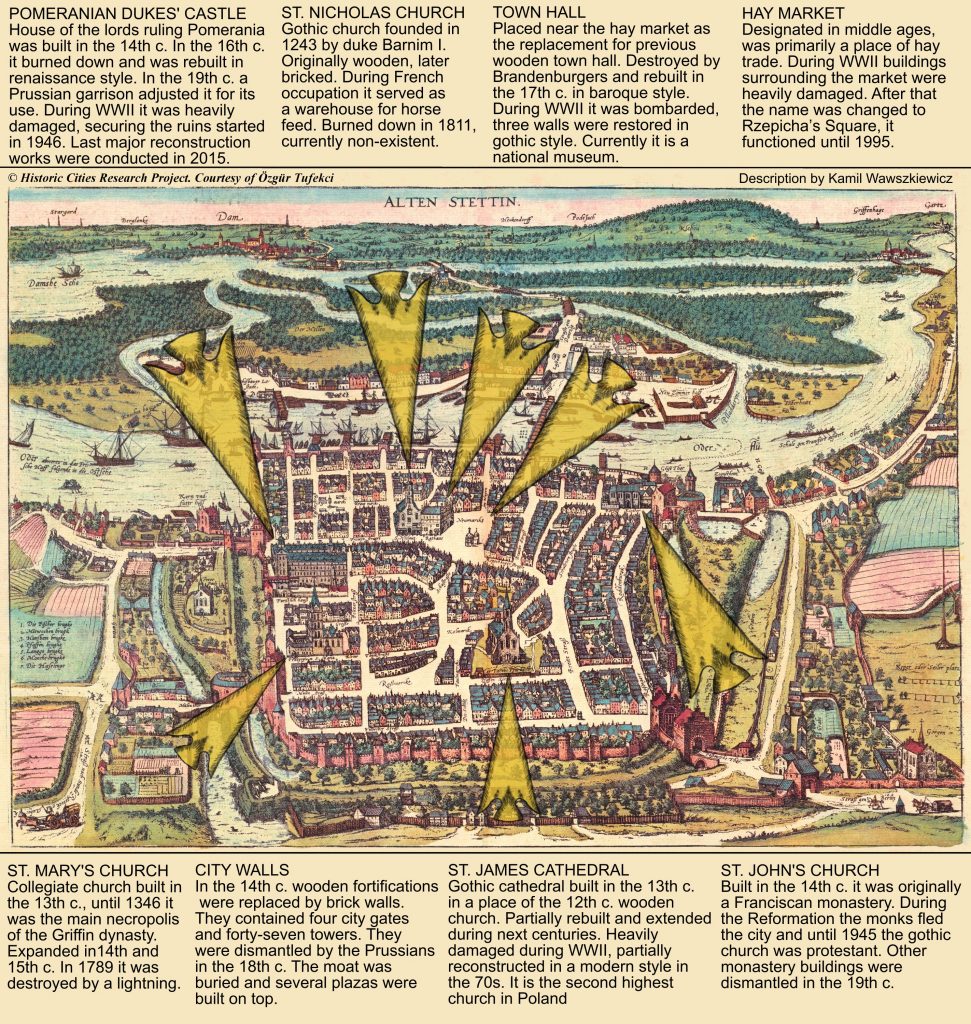CRACOW (Hartmann Schedel, 1493)

The historical view made by Hartmann Schedel is a woodcut from «World’s chronicle’». It shows the sketch of medieval Cracow and accompanying cities Kazimierz and Kleparz. Within Cracow’s walls Hartmann draw Wavel hill with Wavel castle. From this point to Main Square leads Grodzka street. In the Main Square, topped with two towers, St. Mary’s basilica. Buildings in Cracow fill all the space of town. In right down corner – Kleparz. Independent city with St. Florian’s church. Above Kleparz monastery of Norbertanki in the Zwierzyniec. View shows also buildings of benedictin’s abbey in Tyniec. On the left side Kazimierz, separated by big walls which in reality were smaller. Above Kazimierz Krzemionki with St. Benedict’s church. It is the oldest view of «Cracow tricity’». It is a copy of reproduction from collection in State Archives in Cracow.
Located in southern Poland on the Vistula River, the city is located at the confluence of several geographical regions: the Krakow Gate, the Oświęcim Basin, the Sandomierz Basin, the Westbeskid Foothills, and the Krakow-Częstochowa Upland. Its origins are associated with folk legends, later it was a princely, royal city, prosperity and prosperity provided by masses of craftsmen, and artists and scientists contributed to the development of culture and science. The remainder of the former inhabitants of the area of Krakow are two mounds, which may have been places of religious worship, although their destiny is not completely known. They are a mound of Krakus and Wanda. The convenient location on the Wawel Hill and near the Vistula River encouraged permanent settlement. Other residents came to this place, and Krakow slowly became important in the face of other Polish cities.
During the reign of Bolesław Chrobry, a bishopric was established here and the construction of the Wawel cathedral began. The versatile development of the city was conducive to the desire to learn about the city’s origins, which was first described by Wincenty Kadłubek in his chronicle. In 1241, during the Tatar attack on Poland, the first invasion of Krakow took place. The result of this assault was almost total destruction of the city. Already in the twelfth century, a library and cathedral school operated in Kraków, which was considered the best university in Poland at that time. The center of the city was the Wawel Hill, around which numerous scattered merchant and craft settlements were created.
In the urban development of the city of Krakow one can distinguish the following phases, from the natural system, then the checkerboard, through the bypass-radial system, the grid-band system up to the new bypass-radial system with four bypasses. It was not until 5 June 1257, during the reign of Bolesław Wstydliwy, that Krakow was granted a privilege of location under the Magdeburg Law. Thanks to it, there was a chessboard layout of the city, the burghers were exempt from paying taxes for a period of 6 years, they gained the right to fish in Wisła, the commune got the right to own taverns, slaughterhouses and mills. At that time, the Main Market Square was also created, which is the pride of Krakow until today. In 1333, King Casimir the Great crowned Wawel. In 1335, he located a new city in the immediate vicinity of Krakow named after him – Kazimierz. King Casimir the Great made a huge contribution to the development of Krakow and the surrounding area. Thanks to him, trade flourished here, thanks to which the city gained a lot of income and the inhabitants became more and more wealthy. Also many buildings were erected today which are the largest monuments of the city, including Wawel castle. King modernized the city’s fortifications, paved the streets, and founded waterworks.
With the expansion of the city grew its importance. However, the most important event during the reign of Casimir the Great was the founding of the Krakow Academy in 1364, which was the first Polish and one of the most renowned universities in Europe. In the fifteenth century, Krakow experienced cultural and scientific development. Here, among others was taken by Nicolaus Copernicus, an outstanding astronomer, author of the work On the Revolutions of the Heavenly Spheres. At that time Wit Stwosz, a great sculptor, created an altar in the St. Mary’s church.
In 1493, when the view of Schedela was created, Krakow was already a city with rich medieval buildings. During the reign of Władysław Jagiełło, Wawel was clad in huge defensive walls, which are much lower today. Today’s districts of Krakow, Kazimierz and Kleparz, were separate cities with their own defensive walls. Krakow separated from Kazimierz the non-existent branch of the Vistula, which was the natural border between the cities. Krakow is one of the oldest Polish cities with many valuable architectural objects. It has many institutions and cultural institutions gathering priceless monuments. For many years, the capital of the state became a power, towering over many cities of the Polish-Lithuanian Commonwealth and distinguished itself not only by its architecture and heritage, but also by a centuries-long history that in retrospect gives this city prestige and heroic glory.
Monika Łękawska tutored by Dr Natalia Bursiewicz


